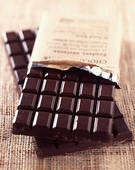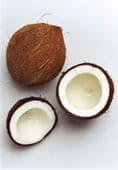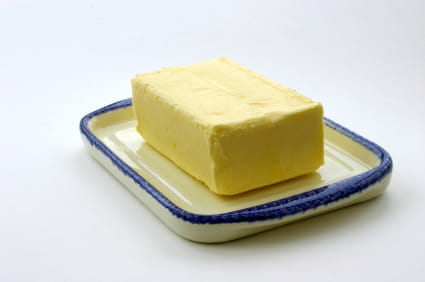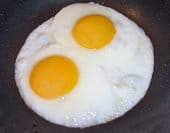Hello again, well I stayed the same this week and I'm fine with that as I am now noticing that my clothes are starting to fit much better so I think I have lost a few inches instead
Below is an article by Mike Geary on foods that you should be having on a Healthy Eating Plan, see what you think......
7 "FATTY" Foods That Can Help You to Get a Flat Stomach (some of these will surprise you!)
These 7 shocking Fatty (but healthy) super-foods can actually help you to burn body fat faster!
by Mike Geary, Certified Personal Trainer, Certified Nutrition Specialist
At this point, the anti-fat propaganda has died and almost everybody understands by now that eating fat doesn't necessarily make you fat. In fact, it's absolutely imperative to get enough healthy fats in your diet to keep your hormones balanced, blood sugar under control, and prevent cravings. Here are 7 examples of "fatty" foods that can actually HELP you to get lean...
 1. Super Dark Chocolate (at least 72% cacao content or higher) - It might not be a secret anymore, but yes, dark chocolate (NOT milk chocolate) can be a very healthy food, even though it is technically calorie dense.
1. Super Dark Chocolate (at least 72% cacao content or higher) - It might not be a secret anymore, but yes, dark chocolate (NOT milk chocolate) can be a very healthy food, even though it is technically calorie dense. However, I would contend that dark chocolate can actually HELP you to burn off more body fat if you're the type of person that has a sweet tooth and likes to eat a lot of desserts. In this case, just 1 or 2 small squares of dark chocolate can many times satisfy your sweet tooth for only 30 or 40 calories as opposed to 500 calories for a piece of chocolate cake or a piece of pie.
Also some brands of dark chocolate that are in the mid 70's in % cacao content or higher, can have a fairly high ratio of fiber content (I've seen some brands have 5 grams of fiber out of 15 grams of total carbs per serving), and relatively low sugar content compared to the amount of healthy fats. In fact, that's one of the "tricks" I use to select a good quality chocolate... I look for more total fat than total carbs (or about the same number of grams of each).
The importance of that fact is that it means many dark chocolates will not greatly affect your blood sugar and will have a fairly blunted blood sugar response compared to other "sweets".
In addition, dark chocolate is also very rich in healthful antioxidants, including a powerful compound called theobromine which has been shown to help lower blood pressure and have other health benefits. The fat content in a good dark chocolate should come solely from the natural healthy fats occuring in cocoa butter and not from any other added fats. Any chocolates with added fats or other additives will generally not be as healthy.
The reason I say to choose dark chocolates with at least 72% cacao content is that the higher the % of cacao, the lower the % of sugar. However, this does mean that any chocolate over 80% cacao content will generally start to get a more bitter taste and have very little sweetness. If you like this type of taste, then the higher % cocao, the better. Otherwise, a good 75% dark chocolate is in my opinion an almost perfect combination of lightly sweet with a rich chocolate taste. Just remember to keep those daily quantities of chocolate small as it is calorie dense!
You can also reap the benefits of the antioxidants and fiber without all of the calories by using organic unsweetened cocoa powder in your smoothies or other recipes.
 2. Coconut milk, coconut flour, and coconut oil -- Coconut milk and oil are great sources of a super healthy type of saturated fat called medium chain triglycerides (MCTs), including a component called lauric acid, which is a powerful nutrient for your immune system, and is lacking in most western diets. In addition, MCTs are readily used for energy by the body and less likely to be stored as bodyfat compared to other types of fats.
2. Coconut milk, coconut flour, and coconut oil -- Coconut milk and oil are great sources of a super healthy type of saturated fat called medium chain triglycerides (MCTs), including a component called lauric acid, which is a powerful nutrient for your immune system, and is lacking in most western diets. In addition, MCTs are readily used for energy by the body and less likely to be stored as bodyfat compared to other types of fats.Along with coconut milk and coconut oil as healthy fat choices, we've also got coconut flour as a healthier flour option for baking. Coconut flour is an extremely high fiber flour alternative (almost ALL of the carbs in this flour are fiber and not starch!). Coconut flour is also VERY high in protein compared to most flours and is also gluten free!
Just beware that if you're going to use coconut flour for baking, it absolutely NEEDS to be mixed with other flours as it sucks up moisture like crazy... I've made delicious baked goods by mixing coconut flour with almond flour and quinoa flour in equal parts, and adding slightly more liquid ingredients than the recipe calls for.
 3. Grass-fed (pasture-raised) butter -- yes, delicious smooth and rich BUTTER (real butter, not deadly margarine!)... It's delicious, contains loads of healthy nutritional factors, and does NOT have to be avoided in order to get lean. In fact, I eat a couple pats of grass-fed butter daily and maintain single digit bodyfat most times of the year.
3. Grass-fed (pasture-raised) butter -- yes, delicious smooth and rich BUTTER (real butter, not deadly margarine!)... It's delicious, contains loads of healthy nutritional factors, and does NOT have to be avoided in order to get lean. In fact, I eat a couple pats of grass-fed butter daily and maintain single digit bodyfat most times of the year.There's a lot of confusion about this topic... in fact, I just saw a TV show today that was talking about unhealthy foods and one of the first things they showed was butter. It just shows that the majority of the population has zero idea that butter (grass-fed only!) can actually be a healthy part of your diet.
In fact, there's even ample evidence that REAL butter can even help you to lose body fat for a couple of main reasons:
a. Grass-fed butter is known to have high levels of a healthy fat called CLA, which has been shown to have anti-cancer properties, and also has been shown to help burn abdominal fat and build lean muscle.
b. Grass-fed butter also has an ideal balance of omega-3 to omega-6 fatty acids (unlike conventional grain-fed butter) which helps fight inflammation in your body, and can help balance hormones.
c. The healthy fats in grass-fed butter also contain MCTs, which help to boost your immune system and are readily burned by the body for energy. The healthy fats in grass-fed butter also help to satisfy your appetite and control blood sugar levels, both of which help you to stay lean!
If you have a hard time finding a grass-fed butter at your grocery store, Kerrygold Irish butter is one of my favorites, and even though the label doesn't clearly state "grass-fed", the cows are 100% grass-fed on lush green pastures in Ireland. It's one of the richest butters in color that I've seen, which indicates high levels of carotenoids.
 4. Whole Eggs, including the yolk (not just egg whites) -- Most people know that eggs are one of the highest quality sources of protein. However, most people don't know that the egg yolks are the healthiest part of the egg... that's where almost all of the vitamins, minerals, and antioxidants (such as lutein) are found in eggs.
4. Whole Eggs, including the yolk (not just egg whites) -- Most people know that eggs are one of the highest quality sources of protein. However, most people don't know that the egg yolks are the healthiest part of the egg... that's where almost all of the vitamins, minerals, and antioxidants (such as lutein) are found in eggs.In fact, the egg yolks contain more than 90% of the calcium, iron, phosphorus, zinc, thiamin, B6, folate, and B12, and panthothenic acid of the egg. In addition, the yolks contain ALL of the fat soluble vitamins A, D, E, and K in the egg, as well as ALL of the essential fatty acids. Also, the protein of whole eggs is more bio-available than egg whites alone due to a more balanced amino acid profile that the yolks help to build.
Just make sure to choose free-range organic eggs instead of normal grocery store eggs. Similar to the grass-fed beef scenerio, the nutrient content of the eggs and the balance between healthy omega-3 fatty acids and inflammatory omega-6 fatty acids (in excess) is controlled by the diet of the hens.
Chickens that are allowed to roam free outside and eat a more natural diet will give you healthier, more nutrient-rich eggs with a healthier fat balance compared with your typical grocery store eggs (that came from chickens fed nothing but soy and corn and crowded inside "egg factories" all day long).
5. Grass-fed beef or bison (NOT the typical grocery store beef!) -- I know most people think that red meat is unhealthy for you, but that's because they do not understand how the health of the animal affects how healthy the meat is for consumption. Keep this in mind -- "an unhealthy animal provides unhealthy meat, but a healthy animal provides healthy meat".
Typical beef or bison that you see at the grocery store is raised on grains, mainly corn (and to some extent, soybeans). Soy and corn are NOT the natural diet of cattle or bison, and therefore changes the chemical balance of fats and other nutrients in the beef or bison. Grain-fed beef and bison is typically WAY too high in omega-6 fats and WAY too low in omega-3 fats. In addition, the practice of feeding cattle corn and soy as the main portion of their diet upsets their digestive system and makes them sick... and it also increases the amount of dangerous e-coli in the meat. This is not the case with grass-fed meat.
 On the other hand, grass-fed beef from cattle and buffalo (or bison) that were raised on the type of natural foods that they were meant to eat in nature (grass and other forage), have much higher levels of healthy omega-3 fats and lower levels of inflammatory omega-6 fats (that most people already eat way too much of) compared to grain fed beef or bison.
On the other hand, grass-fed beef from cattle and buffalo (or bison) that were raised on the type of natural foods that they were meant to eat in nature (grass and other forage), have much higher levels of healthy omega-3 fats and lower levels of inflammatory omega-6 fats (that most people already eat way too much of) compared to grain fed beef or bison. Grass fed meats also typically contain up to 3 times the Vitamin E as in grain fed meats.
In addition, grass-fed meat from healthy cattle or bison also contain a special healthy fat called conjugated linoleic acid (CLA) in MUCH higher levels than grain-fed meat. CLA has been proven in scientific studies in recent years to help in burning fat and building lean muscle (which can help you lose weight!). These benefits are on top of the fact that grass-fed meats are some of the highest quality proteins that you can possibly eat... and this also aids in burning fat and building lean muscle.
Grass-fed meats are a little harder to find, but just ask your butcher or find a specialty grocery store and they usually have cuts available.
6. Avocados -- Even though avocados are typically thought of as a "fatty food", they are chock full of healthy fats! Not only is this fruit (yes, surprisingly, avocados are actually a fruit) super-high in monounsaturated fat, but also chock full of vitamins, minerals, micro-nutrients, and antioxidants.
Also, in my opinion, guacamole (mashed avocados with garlic, onion, tomato, pepper, etc) is one of the most delicious food toppings ever created, and you can be happy to know that it's also one of the healthiest toppings you can use on your foods. Try sliced avocados or guacamole on sandwiches, burgers, eggs or omelets, on salads or with fish, or as a delicious side to just about any meal.
The quality dose of healthy fats, fiber, and micronutrients that you get from avocados helps your body to maintain proper levels of hormones that help with fat loss and muscle building. Also, since avocados are an extremely satiating food, eating them helps to reduce your appetite in the hours after your meal. Say goodbye to junk food cravings and bring on that fat burning! I personally eat anywhere from a half to a full avocado DAILY and it only helps to keep me lean.
7. Nuts: Walnuts, Almonds, Pistachios, Pecans, Brazil Nuts, Macadamias, etc -- Yes, this is yet another "fatty food" that can actually help you burn belly fat! Although nuts are generally between 75-90% fat in terms of a ratio of fat calories to total calories, this is another type of food that is all healthy fats, along with high levels of micronutrients such as vitamins, minerals, and antioxidants. Nuts are also a good source of fiber and protein, which of course, you know helps to control blood sugar and can aid in fat loss.
Nuts also help to maintain good levels of fat burning hormones in your body (adequate healthy fat intake is vitally important to hormone balance) as well as helping to control appetite and cravings so that you essentially eat less calories overall, even though you're consuming a high-fat food. My favorite healthy nuts are pecans, pistachios, almonds, macadamias, and walnuts, and by eating them in variety, you help to broaden the types of vitamins and minerals and also the balance of polyunsaturated to monounsaturated fats you obtain.
Try to find raw nuts instead of roasted nuts if you can, as it helps to maintain the quality and nutritional content of the healthy fats that you will eat.
Also, try to broaden your horizons beyond the typical peanut butter that most people eat, and try almond butter, cashew butter, pecan butter, or macadamia butter to add variety to your diet.
One of the little "tricks" that I've used with clients when trying to cut down body fat is to have them eat a handful of nuts such as almonds or pecans about 20 minutes before lunch and dinner. This ends up being a perfect time to control your appetite before lunch or dinner and helps you to eat less overall calories on that meal.
I hope you enjoyed this look at some of the healthiest "fatty" fat-burning foods you can possibly eat. I could list a ton more, but wanted to give you a few of my favorites for now. Enjoy!
For further information on Healthy "FATTY" Foods please
CLICK HERE
Alison
